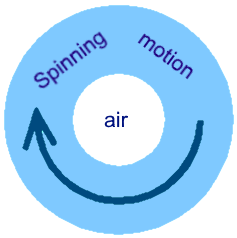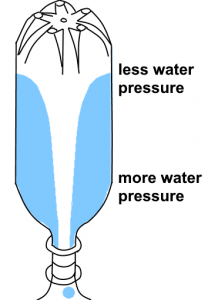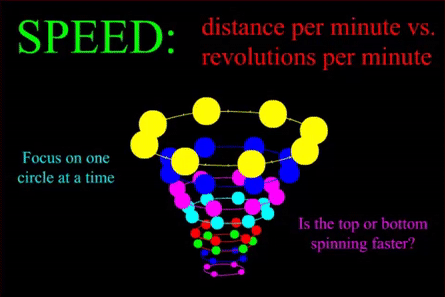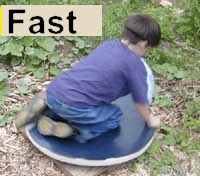Why does the vortex form?
Let's start with the observation that sometimes it doesn't. Have you noticed that if you just turn over the bottles without spinning the water, you get a bunch of bubbles as the water dribbles from the upper bottle to the lower one. It is important to realize that there is something in both bottles: water in one, air in the other. They awkwardly try to pass each other in the bottle necks.
 Once you start the water spinning, everything changes. According to Sir Isaac Newton's first law of motion, the water will move in a straight line unless something changes its direction. The side of the bottle constantly changes the direction of the water. The net effect is that the water pushes itself against the wall of the bottle. Actually, the spinning air is also pushing toward the outside, but being less dense, it is shoved into the center by the heavier water.
Once you start the water spinning, everything changes. According to Sir Isaac Newton's first law of motion, the water will move in a straight line unless something changes its direction. The side of the bottle constantly changes the direction of the water. The net effect is that the water pushes itself against the wall of the bottle. Actually, the spinning air is also pushing toward the outside, but being less dense, it is shoved into the center by the heavier water.

We see this centripetal force again and again in technology. Washing machines throw water out of clothes during the spin cycle so less drying has to be done. Hospital labs analyze blood by centrifuging it so hard that it separates into layers (milk/cream separators also work this way). Beekeepers extract honey from the hexagonal wax cells with centrifugal spinning extractors. Fighter jet pilots wear special suits to help keep the blood in their brains from being pushed into their lower extremities during high-speed, banked turns. Those pilots can lose consciousness when they "pull G's", so named because the force they withstand during sharp turns is measured in multiples of regular gravitational force.
The heavy water, as it falls to a lower level, converts its potential energy to kinetic (moving) energy. This process overcomes friction and keeps the whole thing going.
I believe the vortex is wider on top because there is less water pressure there. Further down the greater water pressure squeezes the air to a narrower tube.

You will find that you can make the vortex rotate either way by the direction you spin it in. In macro events like hurricanes, the direction is determined by the Coriolis effect.
So how does this relate to real tornados and hurricanes?
It's pretty easy to see that dense water in the top bottle will be drawn downward by gravity, displacing the less-dense air in the bottom. It is harder to grasp the fact that cold, dry air is heavier than moist, warm air. When a moisture laden weather system collides with a dry air mass, the difference in density powers tornados and hurricanes. This is analogous to the way the difference in density between the water on top and the air below powers our model tornado.
Remember when we cooled the air in the bottles before sealing them? We did it to keep the top bottle from denting, but we can use the idea to demonstrate how cool air is denser than warm air. Put a lid tightly on a soda bottle at room temperature. Then stick it in a freezer for one minute. You will see the bottle dent. You have the same number of air molecules stuck in the bottle, and they weigh the same. But now they are taking up less space. That's what density is about: how much of something you have and how much space it takes up. The cold air is denser than the hot air because the same amount takes up less space.
Why does the vortex spin faster at the bottom?
If you put little bits of plastic in your bottles before you sealed them, you might have noticed that they seem to speed up as they get near the center of the bottle. I made an animation of a vortex to demonstrate this.

To see what's going on, you have to differentiate two methods of measuring speed. Here is another animation that will help you sort them out. Pressing the button switches from equal revolutions per minute to equal distance per minute, and back. At the bottom of a vortex, if the water is forced to spin in a tighter circle it must increase its rpm's (revolutions per minute) to maintain the same speed!

 I made a turntable that is big enough for people to spin on. I instruct kids to lie down on their stomachs, stretch out so much of their mass (weight {sort of}) is far from the center of rotation, and start themselves spinning. Then--without touching the ground-- they pull themselves into the center. They seem to magically speed up, but of course the rpm's have to increase to maintain the same mph (miles per hour). This is how ice skaters spin themselves into a blur at the end of a routine. I first noticed it as a kid when I twisted myself up in a swing. By leaning back and sticking my legs out I could slow down my spinning drastically.
I made a turntable that is big enough for people to spin on. I instruct kids to lie down on their stomachs, stretch out so much of their mass (weight {sort of}) is far from the center of rotation, and start themselves spinning. Then--without touching the ground-- they pull themselves into the center. They seem to magically speed up, but of course the rpm's have to increase to maintain the same mph (miles per hour). This is how ice skaters spin themselves into a blur at the end of a routine. I first noticed it as a kid when I twisted myself up in a swing. By leaning back and sticking my legs out I could slow down my spinning drastically.
I'd like to know how this project goes for you. I'm happy to answer questions about it. Feedback from you is an important way for me to know what works and what needs clarification. Please contact me or leave a message in the comment section.
